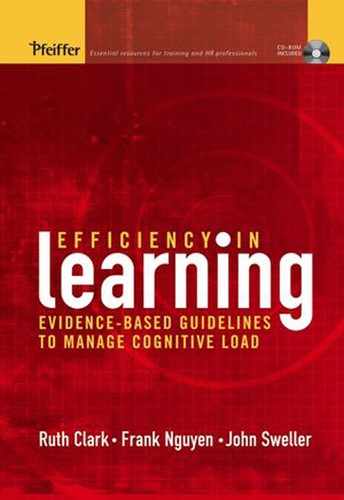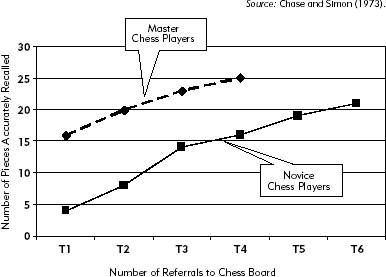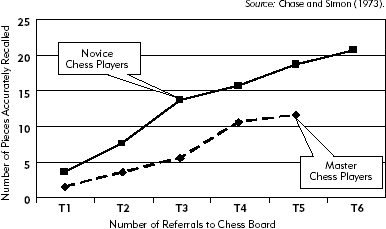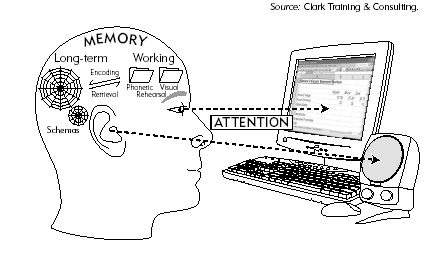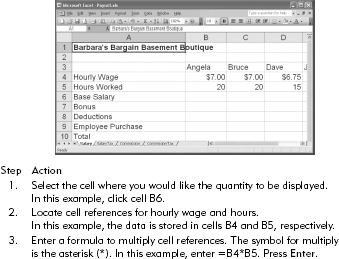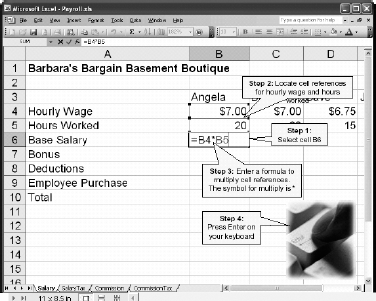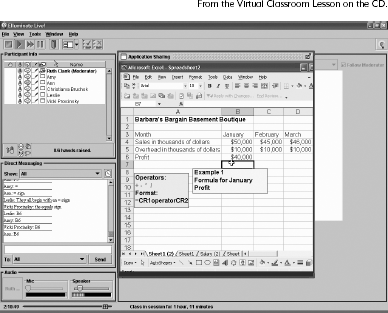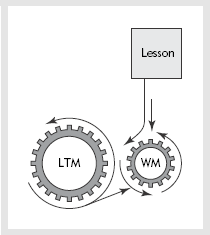
In Chapter 1 we defined efficient instruction as training that leads to better learning outcomes with less mental effort. Efficient learning leads to better achievement of instructional goals and/or faster learning. When you apply our cognitive load guidelines to your instructional environment, you help your learners use their mental resources to their best advantage. Unlike many popular training programs, cognitive load theory is based on human learning processes. As we discussed in Chapter 1, there are no straightforward applications of our guidelines because they depend on an interaction among the learner's prior knowledge, the complexity of the content and tasks, and the instructional environment. Therefore, you will need to tailor these guidelines to your own unique situation. Understanding not only the what's of cognitive load theory but also the why's will help you design and deliver efficient training. This chapter focuses specifically on those human learning processes that make up the why's of cognitive load theory.
In this chapter we discuss working and long-term memory systems and the main psychological events involved in learning that must be accommodated in efficient instructional environments. In particular we will see how our guidelines work to compensate for lack of knowledge in the long-term memory of novices.
All human learning and work activities rely on two of our memory systems—working memory and long-term memory and the partnership they share. As its name implies, working memory is the active partner. As you read this book and think about how it applies to your work, it is your working memory that does the processing. While in a learning mode, new information from the environment is processed in working memory to form knowledge structures called schemas, which are stored in long-term memory. Schemas are memory structures that permit us to treat a large number of information elements as though they are a single element. For example, when you read the word "element" you no longer think of seven separate letters; you think of a single entity, the word "element."
We have schemas for all aspects of our cognitive lives. While all trees differ from all other trees and include a huge amount of sensory information (color, shape, number of leaves, twigs, branches, and so forth), we can instantly recognize an object as a tree because we have a schema for trees. We similarly have schemas for letters, words, and combinations of words that allow us to read easily and rapidly. Schemas for the solution to specific mathematics problems may make us competent at mathematics. In any area in which you have competence, that competence derives from schemas stored in your long-term memory.
Long-term memory is the main knowledge repository because working memory has very little storage capacity. Working memory's main role is conscious processing. When you ask working memory to store anything beyond very limited amounts of information, its processing capacity is inadequate. We've all had the experience of being overwhelmed when trying to learn something new. That feeling of failing to understand leading to frustration or anxiety is your working memory telling you that it is overloaded. Overload stresses psychological processes in ways that diminish learning efficiency. When overload gets large enough, the learning system shuts down altogether. Your job as an instructional professional is to design and deliver training that will leverage germane cognitive load to promote learning and at the same time to minimize extraneous load and manage intrinsic cognitive load to free working memory capacity for learning.
The limits of working memory capacity were first made explicit in George Miller's 1956 paper: The Magical Number Seven Plus or Minus Two. The phrase 7 ± 2, refers to limited working memory capacity. Not only is the storage capacity of working memory very limited, but so also is the duration of anything that enters working memory. Unless you actively keep new data alive in working memory through repetition or process it for storage into long-term memory, even small amounts of new information will disappear from consciousness in just a few seconds.
As a result of these working memory limits, if you look at a mid-play chess board very briefly, say for five seconds, you would probably only be able to recall the location of a few chess pieces. Chase and Simon (1973) counted how many times novice chess players needed to refer back to a mid-play board like this one in order to accurately reconstruct it from memory. As you can see from the solid line in Figure 2.1, novice chess players needed to refer back to the board more than six times before they were able to reconstruct most of it. However, when faced with the same task, expert chess players had a different experience. As you can see from the broken line in Figure 2.1, master level chess players were able to recall the chess pieces with only a few referrals. From this experiment, we see that we need to revise our conception of 7 ± 2. While the 7 ± 2 chunks capacity limit is the same for everyone, chunk size varies. People with experience in a domain can form chunks of much greater size and in this way expand the virtual capacity of their working memory.
What are chunks? These days, most people equate them with schemas. A large chunk is simply an extensive, sophisticated schema and for that reason we will use the term schema from this point on. Where are schemas stored? In long-term memory that we discuss next.
In contrast to working memory, long-term memory has a massive capacity for information storage. However, it is the inert member of the memory partnership. All conscious processing takes place in working memory. But working memory and long-term memory work closely together. The more knowledge and skills stored in long-term memory, the greater the virtual capacity of working memory as a result of larger, more complex schemas. For example, a chess board includes about twenty-four elements of information for a novice player. However, experts represent the chess board in play patterns involving clusters of several pieces. Each cluster translates into a schema. Therefore the chess board of twenty-four pieces contains approximately eight or nine schemas for a chess expert.
The recall of chess pieces shown in Figure 2.1 was based on a mid-play chess board. How would a random placement of chess pieces on the board affect the recall results? We might expect that experts would lose their advantage and need about the same number of referrals as novices. Chase and Simon (1973) tested this hypothesis. As you can see in Figure 2.2, expert player performance was actually worse than novice performance when trying to reconstruct a random chess board! The experts were trying to apply their schemas for chess play patterns to a meaningless environment. The extra psychological work they expended trying to make sense of what they were viewing depressed their memory performance so they were worse off than the novice players!
As a result of their enhanced schemas, experts have significantly different psychological capabilities than novices. Experts are able to tackle complex tasks that overwhelm less experienced workers. When learning new skills in their domain, experts are enabled by their rich storehouse of schemas to process much larger amounts of information as well as to guide much of their own learning processes. Novices, in contrast, lack such schemas and therefore need learning environments that compensate for them. Well-designed learning environments for novices provide schema substitutes by optimizing the limited capacity of working memory in ways that free working memory for learning. For example, packed lessons loaded with new knowledge and skills will overwhelm novice learners. Good instruction will segment and sequence the content in ways that reduce the amount of new information novices must process at one time.
In contrast, experts can handle many elements of information because the elements are incorporated in a schema that is treated as a single element in working memory. Therefore, experts do not need the same instructional support as novices. For example, learners with some domain experience learn a new skill best by practicing it right away. In contrast, novices are overloaded by the mental demands of extensive practice and learn more efficiently when they can first study worked examples to help them build new schemas. In short, effective training environments for novices are designed to substitute for the schemas that learners with relevant experience already have.
As we will discuss in Chapter 10, many of the instructional techniques that serve as schema substitutes for novices don't work for experienced learners, who possess relevant schemas. In fact, like the expert chess players facing a random chess board, instructional environments designed for novices actually depress learning outcomes of experienced learners—an effect known in cognitive load theory as expertise reversal. In Chapters 10 and 11 we will describe in greater detail how to transition your training as learners gain expertise.
In summary we see that working memory has a limited capacity of 7 ± 2 information elements. However, not all information elements are equal. The size of any given element depends on the prior knowledge of the learner based on preexisting schemas stored in long-term memory. This is why experienced workers can easily handle complex tasks that are overwhelming for new workers. Similarly, when experienced workers serve as instructors, they often overload their learners by failing to compensate for the much more limited schemas of the learners. To compensate for lack of schemas in LTM of novices, efficient instructional environments based on cognitive load theory offer the psychological support that such schemas provide more experienced learners.
In the last twenty-five years, we have learned more about working memory. Most relevant to instructional efficiency is the finding that working memory incorporates separate components. One component is for visual information and another one is for auditory (phonetic) information as represented by the two folders in Figure 2.3. While each of these working memory components is quite limited, we will see in Chapter 3 that under some defined circumstances you can maximize working memory capacity by using both components to explain visuals with words delivered in audio narration rather than by text.
The visual and auditory subcomponents of working memory were inferred by performance outcomes from dual task experiments. Dual task experiments require multitasking. In a dual task experiment, participants are assigned a primary task such as to recall a list of numbers that is read to them at the same time as they perform a secondary task. A secondary task might require the participant to strike a key when they hear a tone or track a moving dot on a computer screen using a joy stick. Psychologists conducting dual task experiments found that, when participants are asked to perform a secondary auditory task (respond to a tone) while performing a primary auditory task (recall a list of numbers read aloud), performance on one or both tasks suffers. However, performing a secondary task that is visual (tracing a moving dot) while performing a primary auditory task leads to minimal performance declines. The reason for these results is that two tasks that involve the same modality, for example, both visual or both auditory, drain the limited working memory capacity in that center. In contrast, two tasks that call on different modalities, for example, one visual and one auditory, make use of the separate subcomponents in working memory.
The goal of your instructional program is to free limited working memory from irrelevant mental effort and harness it for the work required to integrate new knowledge and skills into the schemas in long-term memory. Productive mental effort needed to build effective new schemas is what we call germane cognitive load. Studying examples is one type of germane cognitive load that leads to schema development in long-term memory. Unproductive mental effort that does not lead to learning is what we call extraneous cognitive load. For example, requiring learners to study an example in which a visual is explained by text that is separated from the graphic, such as the one shown in Figure 2.4, imposes extraneous cognitive load. That is because working memory must invest extra effort to search for relations between the text and graphic. Instead, the improved visual in Figure 2.5 integrates the text explanations close to the visual elements being explained, reducing the need to search for relevant relations. In this way, the instructional display saves the mental work that learners have to invest when studying separated displays. That extra capacity can be devoted to processing the example and building a schema from it. Programs with considerable extraneous cognitive load lead to inefficient learning.
We also preserve the limited resources of working memory by reducing intrinsic cognitive load that results from the complexity of the new knowledge and skills to be learned. As we will discuss in Chapter 7, you reduce intrinsic load by segmenting and sequencing content in ways that control the amount of new information the learner must process at one time.
As illustrated in Figure 2.3, visual and auditory information that is attended from the instructional environment enters working memory. Unattended information does not enter the processing system. Once in working memory, mental effort is used to integrate the visual and auditory information in order to form a coherent message. Next, working memory must integrate the new information into preexisting related schemas that are brought into working memory from long-term memory. If successful, the result is an expanded schema in long-term memory that has integrated the new knowledge and skills from the instructional environment.
The following psychological processes summarized in Figure 2.3 work in concert to achieve learning goals: attention, activation of prior knowledge, elaboration-rehearsal, encoding and retrieval. First, learners must focus their attention on the instructional information that is relevant to the learning goal. Attention is critical in order to screen out irrelevant information that will clog working memory and to put relevant data into working memory. New information entering working memory must be integrated into preexisting schemas in long-term memory. Therefore those schemas must be transferred from long-term memory into working memory. This transfer is called activation of relevant preexisting knowledge. At this point, working memory must process new knowledge and skills in order to integrate them into the activated schemas from long-term memory. This processing is called elaboration of information. Elaboration of information results from rehearsal of new content in working memory. As a result of rehearsal and elaboration, incoming content from the instructional environment is transformed to result in expanded schemas stored in long-term memory. The result is encoding of new knowledge and skills in long-term memory.
However, we can't claim successful learning yet. It's not sufficient to form new schemas in long-term memory. Since all conscious activity occurs in working memory, those new schemas must be brought back into working memory when needed on the job. This process is called retrieval. Retrieval of new knowledge and skills is the psychological basis for transfer of learning. Successful transfer means that new knowledge and skills acquired during training are available for use later in the work environment. If you've ever struggled to apply something that was covered in a training class, you know that transfer of learning is not always easy.
Learning transfer will depend on how new schemas are formed. Schemas that incorporate relevant cues that reflect the context of the job are more likely to transfer than schemas lacking such cues. For example, when learning a new computer application, if the training program uses screens similar to those you will see on the job, your new schema will incorporate those visual cues. When you see those screens in the workplace, you are more likely to retrieve the new procedure since it was learned in conjunction with those screens.
All of these processes rely on mental effort invested by working memory. If training programs require working memory to expend additional effort not directly related to these processes, learning slows and becomes inefficient. To review these learning processes in greater detail, refer to our recommended readings at the end of this chapter.
Your training programs should use instructional methods that promote the key learning events summarized in the previous paragraph and at the same time avoid disrupting them. For example, in the beginning of our demonstration virtual classroom lesson on Excel from the CD, the instructor presents learning objectives to help participants focus their attention on content relevant to the expected outcomes of the training. During the lesson introduction, a quick review of a prior lesson on cell references helps activate relevant prior knowledge. This makes the related schemas available in working memory for addition of the new content. The instructor promotes elaboration and rehearsal by asking questions that require learners to study and draw conclusions from the examples, as well as to complete a demonstration that the instructor begins. By using job-realistic situations and work environments during the lesson, the instructor is helping learners build schemas that are likely to transfer later. For example in the Excel lesson, as shown in Figure 2.6, the instructor uses an actual spreadsheet with different job-realistic contexts for demonstrations and practice.
So far we have reviewed two vehicles for maximizing the limited capacities of working memory. First, as individuals gain expertise, their schemas in long-term memory grow, and consequently they are able to process larger content segments. In this way, the virtual capacity of working memory expands. Prior to this point, the instructional environment must substitute for limited schemas of novices by segmenting, sequencing, and presenting content in ways that will avoid overload. Second, we saw that judicious use of the auditory and visual subcomponents of working memory, allow us to maximize its limited capacity. Automaticity is a third psychological mechanism that can allow you to largely bypass working memory limits.
Any task that is performed hundreds of times becomes established in long-term memory. Once automated, the skill can be performed with little or no resources from working memory. In effect, these skills are performed unconsciously. For example, as I write this paragraph, I can type the words automatically. Since I do not need to invest any mental resource in the typing, I can use limited working memory capacity to compose meaningful sentences and paragraphs. All of us have the benefit of automated skills in long-term memory that free up working memory resources. As another example, you are able to read this paragraph very quickly because as an expert reader you have automated the decoding skills of the English language. Unless you are bilingual, however, if you were to read this book in Italian, your reading speed and comprehension would be greatly slowed.
The path to automaticity is a long one requiring many hundreds of practice repetitions. Most organizational training programs do not allocate sufficient time to reach skill automaticity. New tasks that are performed frequently become automated after training as a result of job experience. Other new tasks that are not performed frequently will require conscious working memory capacity to perform. Good reference materials will help learners perform infrequent tasks more effectively. In Chapter 6 we summarize guidelines for the design and production of effective reference aids.
In this chapter we laid the psychological foundation for cognitive load theory as follows:
The guidelines that emerge from cognitive load theory are based on maximizing limited working memory resources, which can then be allocated to more efficient building of schemas in long-term memory.
Experts in a domain have a rich repository of schemas in long-term memory that allow them to use their working memory resources more efficiently.
Novices need support from the instructional environment to substitute for their lack of schemas.
Five essential instructional events mediate the transformation of new knowledge and skills from the learning environment into transferable schemas in long-term memory: attention to relevant instructional content; activation of related prior knowledge stored in long-term memory; elaboration of new content during rehearsal; encoding of new schemas in long-term memory; and retrieval of these schemas later when needed in the workplace.
All of the instructional events rely on working memory capacity and should be supported by instructional methods that manage cognitive load.
Chapter 2: The Psychology of Efficiency. In his discussion of human cognition, John includes the features of working memory, the consequences of limited working memory on human thinking processes, features of long-term memory, including schemas, the importance of long-term memory to human cognition, and the process of automaticity.
The Virtual Classroom Example illustrates the application of the psychological events of learning as follows:
Attention—supported by cueing with the highlighter of relevant portions of the spreadsheet as well as setting of ground rules to limit the potential for distraction from use of diverse features of the virtual classroom interface.
Activation of prior knowledge—supported by a review of spreadsheet row and column designations.
Elaboration, Rehearsal, Encoding—supported by frequent questions requiring learners to process and apply new knowledge and skills.
Retrieval—supported by use of Excel interface and realistic job contexts as the basis for examples and practice.
In Part II of the book we present guidelines and research regarding ways that instructional professionals can minimize extraneous cognitive load. In Chapter 3 we look at ways to minimize extraneous cognitive load by leveraging the auditory and the visual subcomponents of working memory. We will review guidelines related to use of visuals alone and to explanations of visuals that result in more efficient instructional environments.
